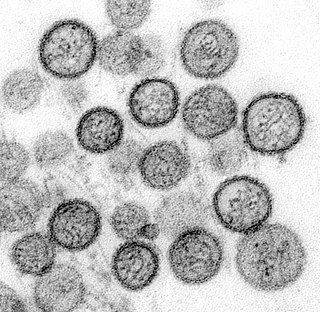
Orthohantavirus is a genus of single-stranded, enveloped, negative-sense RNA viruses in the family Hantaviridae within the order Bunyavirales. Members of this genus may be called orthohantaviruses or simply hantaviruses.

Sin Nombre orthohantavirus (SNV) is the prototypical etiologic agent of hantavirus cardiopulmonary syndrome (HCPS).
Seoul orthohantavirus (SEOV) is a member of the Orthohantavirus family of rodent-borne viruses and is one of the 4 hantaviruses that are known to be able to cause Hantavirus hemorrhagic fever with renal syndrome (HFRS). It is an Old World hantavirus; a negative sense, single-stranded, tri-segmented RNA virus.

Andes orthohantavirus (ANDV), a species of Orthohantavirus, is a major causative agent of hantavirus cardiopulmonary syndrome (HCPS) and hantavirus pulmonary syndrome (HPS) in South America. It is named for the Andes mountains of Chile and Argentina, where it was first discovered. Originating in the reservoir of rodents, Andes orthohantavirus is easily transmitted to humans who come into contact with infected rodents or their fecal droppings. However, infected rodents do not appear ill, so there is no readily apparent indicator to determine whether the rodent is infected or not. Additionally, Andes orthohantavirus, specifically, is the only hantavirus that can be spread by human to human contact via bodily fluids or long-term contact from one infected individual to a healthy person.
Black Creek Canal orthohantavirus (BCCV) is a single-stranded, negative sense RNA virus species of New World Orthohantavirus. It was first isolated in cotton rats found in the Black Creek Canal area of Dade County, Florida in 1995. The discovery followed from an isolated case of Hantavirus pulmonary syndrome diagnosed in a Dade County resident.
Sangassou orthohantavirus(SANGV) is single-stranded, negative-sense RNA virus species of the genus Orthohantavirus in the Bunyavirales order. It was first isolated in an African wood mouse in the forest in Guinea, West Africa in 2010. It is named for the village near where the mouse was trapped. It is the first indigenous Murinae-associated African hantavirus to be discovered.

Hantavirus hemorrhagic fever with renal syndrome (HFRS) is a group of clinically similar illnesses caused by species of hantaviruses. It is also known as Korean hemorrhagic fever and epidemic hemorrhagic fever. It is found in Europe, Asia, and Africa. The species that cause HFRS include Hantaan orthohantavirus, Dobrava-Belgrade orthohantavirus, Saaremaa virus, Seoul orthohantavirus, Puumala orthohantavirus and other orthohantaviruses. Of these species, Hantaan River virus and Dobrava-Belgrade virus cause the most severe form of the syndrome and have the highest morbidity rates. When caused by the Puumala virus, it is also called nephropathia epidemica. This infection is known as sorkfeber in Swedish, myyräkuume in Finnish, and musepest in Norwegian.

Hantavirus pulmonary syndrome (HPS) is one of two potentially fatal syndromes of zoonotic origin caused by species of hantavirus. These include Black Creek Canal virus (BCCV), New York orthohantavirus (NYV), Monongahela virus (MGLV), Sin Nombre orthohantavirus (SNV), and certain other members of hantavirus genera that are native to the United States and Canada.
Soochong virus (SOOV) is a zoonotic negative sense single-stranded RNA virus. It may be a member of the genus Orthohantavirus, but it has not be definitively classified as a species and may only be a strain. It is one of four rodent-borne Hantaviruses found in the Republic of Korea. It is the etiologic agent for Hantavirus hemorrhagic fever with renal syndrome (HFRS). The other species responsible for HFRS in Korea are Seoul virus, Haantan virus, and Muju virus.
Muju virus(MUV) is a zoonotic negative-sense single-stranded RNA virus of the genus Orthohantavirus. It is a member virus of Puumala orthohantavirus. It is one of four rodent-borne Hantaviruses found in the Republic of Korea. It is the etiologic agent for Hantavirus hemorrhagic fever with renal syndrome (HFRS). The other species responsible for HFRS in Korea are Seoul orthohantavirus, Hantaan orthohantavirus, and Soochong virus.
Limestone Canyon virus (LSC) is a single-stranded, negative-sense RNA zoonotic Orthohantavirus that is genetically similar to Sin Nombre orthohantavirus which causes Hantavirus pulmonary syndrome (HPS) in humans. HPS causing hantaviruses are found only in the United States and South America.
Hantaan orthohantavirus (HTNV) is an enveloped, single-stranded, negative-sense RNA virus species of Old World Orthohantavirus. It is the causative agent of Korean hemorrhagic fever in humans. It is named for the Hantan River in South Korea, and in turn lends the name to its genus Orthohantavirus and family Hantaviridae.
Topografov virus is an enveloped, negative-sense RNA virus of the genus Orthohantavirus in the Bunyavirales order. It is the first hantavirus to be isolated from Siberian lemmings found near the Topografov River in the Taymyr Peninsula, Siberia.
Choclo orthohantavirus (CHOV) is a single-stranded, negative-sense RNA zoonotic New World hantavirus. It was first isolated in 1999 in western Panama. The finding marked the first time Hantavirus pulmonary syndrome (HPS) was found in Central America.
Calabazo virus is an enveloped, single-stranded, negative-sense RNA hantavirus species of the order Bunyavirales. It is a novel New World microtine rodent-borne hantavirus discovered in Central America on the Azuero Peninsula of Panama in early 2000. Human infection with Calabazo virus results in respiratory illness similar to Hantavirus pulmonary syndrome but it is not severe or fatal and rarely requires hospitalization.
Oxbow virus(OXBV) is a single-stranded, enveloped, negative-sense RNA orthohantavirus.
Thailand virus (THAIV) is a single-stranded, enveloped, negative-sense RNA orthohantavirus.
Gou virus (GOUV) is a single-stranded, negative-sense, enveloped novel RNA orthohantavirus. It is one of the known hantaviruses responsible for hantavirus hemorrhagic fever with renal syndrome in humans.
Blue River virus (BRV) is a single-stranded, negative sense RNA virus of New World hantavirus isolated from a white-footed mouse near the Blue River in Jackson County, Missouri in 1995. Its genome is similar to Sin Nombre orthohantavirus (SNV) but varies in the S1 and S2 segments. Like Sin Nombre orthohantavirus, Blue River virus causes Hantavirus pulmonary syndrome (HPS) in humans.
Bloodland Lake virus (BLLV) is a single-stranded, negative-sense RNA virus of New World Orthohantavirus first isolated in a Prairie vole near Bloodland Lake, Fort Leonard Wood, Pulaski County, Missouri in 1994. BLLV has also been isolated in Prairie voles in St. Louis County, Missouri.



